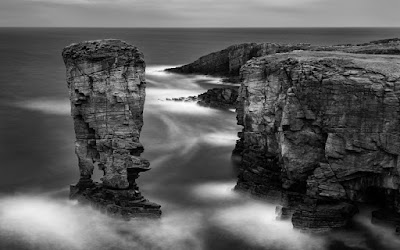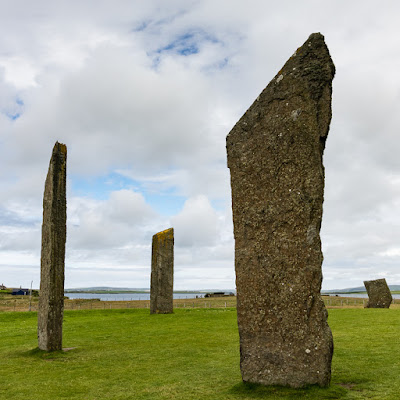I have saved the most iconic Orkney location until last. The Ring of Brodgar is an almost 104 metre wide neolithic stone circle and henge. It is originally thought to have contained 60 stones, but today only 27 remain. During my stay on the Orkney mainland, half of the ring had been fenced off, to allow drainage improvements to the path. Fortunately, the other half of the ring was clear of obstructions. It was also a short drive from where I was staying, making it an ideal location to try for a sunrise.
Despite it being the last week in July, sunrise was still just before 5am, with sunset just before 10pm. On a couple of mornings during the week, I had looked out my bedroom window at 4.30am or so, to check out the prospects, and decided to go back to bed. It wasn't until the last day that it was worth actually getting up and out. I arrived at the ring just before the sun broke the horizon. Once it did, the stones took on a beautiful golden glow. This only lasted about half an hour. After that the sun reached a bank of cloud and that was that.
I mentioned in an earlier post that, aside from the periodic coaches of day trippers, there weren't that many visitors to get in the way wherever I went. But one thing that amazed me, given the photographic opportunities, was the complete absence of other serious 'togs. I didn't see a single other tripod in 7 days. You can visit the Castlerigg Stone Circle in the Lakes, for any given sunrise, and be certain to share your experience with a few other photographers. At Brodgar there was not a soul around to trouble me. In fact, it was so deserted that a small Imp of the Perverse in my head said I should 'do a Billy Connolly'. But, dear reader, you will be pleased to know I resisted. Besides, I wanted to shoot another location before breakfast.
Wednesday, 28 September 2016
Sunday, 18 September 2016
Orkney - The Coast
Just two more posts of images from Orkney, before I (finally) move on to other things. What Orkney lacks in hills it more than makes up for with its coastline. Small golden beaches and large dramatic cliffs. I loved the cliffs at Yesnaby, on the west coast. In particular this sea stack with a hole near the base. As I looked at it, I wondered how many more winter storms it could survive. I revisited the location a couple of times, hoping to get good light. Sadly, it never came quite right. Even so, I quite like this 10-stop image.
Wednesday, 14 September 2016
Orkney - St Magnus Cathedral
St Magnus Cathedral, in Kirkwall, is known as the 'Light in the North' and is the most northerly cathedral in the British Isles. It was founded in 1137 by the Viking, Earl Rognvald, in honour of his uncle St Magnus. The building uses a combination of red and yellow sandstone, often in alternating courses or a chequerboard pattern. Due to its age, the windows of St Magnus are much smaller than found in most later churches.
The cathedral is free to visit. I went on a rainy morning, but even so there weren't that many visitors. I don't think it's a stop for the coach tours. The staff were lovely. A quick word and they gave me permission to shoot with a tripod (no specific permit required). One of them later told me the story of a time when a chap walked in and asked to shoot with a large format camera. Permission given, he set to work. Then another dozen other 'togs walked in, all of them also sporting large format cameras. They, apparently, were a club on an outing. But the first chap had nothing to do with them. He just happened to be out on the same day. He probably thought he'd get the place all to himself. Bet he was annoyed.
The cathedral is free to visit. I went on a rainy morning, but even so there weren't that many visitors. I don't think it's a stop for the coach tours. The staff were lovely. A quick word and they gave me permission to shoot with a tripod (no specific permit required). One of them later told me the story of a time when a chap walked in and asked to shoot with a large format camera. Permission given, he set to work. Then another dozen other 'togs walked in, all of them also sporting large format cameras. They, apparently, were a club on an outing. But the first chap had nothing to do with them. He just happened to be out on the same day. He probably thought he'd get the place all to himself. Bet he was annoyed.
Thursday, 8 September 2016
Orkney - Stenness
Although Stenness is a smaller circle than that at Brodgar, the stones themselves are much bigger, with a maximum height of six metres. Four stones remain, from an original 10 or 12 that were laid out in an ellipse. At the centre of the ring is a large stone hearth, similar to those found in Skara Brae and other Neolithic settlements.
A quick note on photography in Orkney. First off, the weather. Weather forecasts can only be trusted for the following hour, after that they become increasing random guesses. With no hills, few trees and no major land masses to the west until you reach Newfoundland, weather fronts seem to whip through the isles. Yes, of course it’s going to rain! It’s the far north of Scotland, what did you expect? But in Orkney, more so than anywhere else I’ve been in the UK, the old joke applies that, ‘if you don’t like the weather, just wait 10 minutes’. Secondly, people. The other touristy types who like to stand in front of you just as you're trying to take a shot. Given the location, it should probably not be surprising that the many attractions Orkney has to offer aren’t constantly thronged by visitors. What there are, however, are coachloads of day-trippers, intent on seeing all that Orkney has to offer in a single hit. It can be rather disheartening to turn up somewhere at the exact time as a couple of 57-seaters. All you can do is wait them out. Fortunately their itineraries preclude them from staying at one location for too long (“and we’re walking, we’re walking”). Just watch out for the next coach.
A short walk past the stones, on the shores of Loch Harray, is the remains of the neolithic Barnhouse Settlement. Only the partially reconstructed foundations of the buildings remain. These are thought to date from between 3300 and 2600 BC. A total of 15 buildings were unearthed during an archaeological dig in the 1980's. The houses were similar in construction to those at Skara Brae, but were free standing rather than built into the earth and a midden pile. From their layouts, two of the buildings, 'Structure 2' and 'Structure 8', are thought to have been used for ceremonial purposes, rather than as dwellings. It is also thought that 'Structure 8', which is aligned with the Barnhouse Stone and Maeshowe, was built after the rest of the village had been abandoned and purposefully destroyed.
Monday, 5 September 2016
Orkney - Skaill House
Skaill House is a 17th century manor house, that was home to William Watt, 7th Laird of Breckness, who first excavated Skara Brae. It is a short walk from the neolithic village and entry is included in a joint ticket. The house was originally built in 1620 by Bishop George Graham (Bishop of Orkney 1615-1638), and was added to by successive generations. The interior is now presented as it would have looked in the 1950s.
Subscribe to:
Comments (Atom)





































